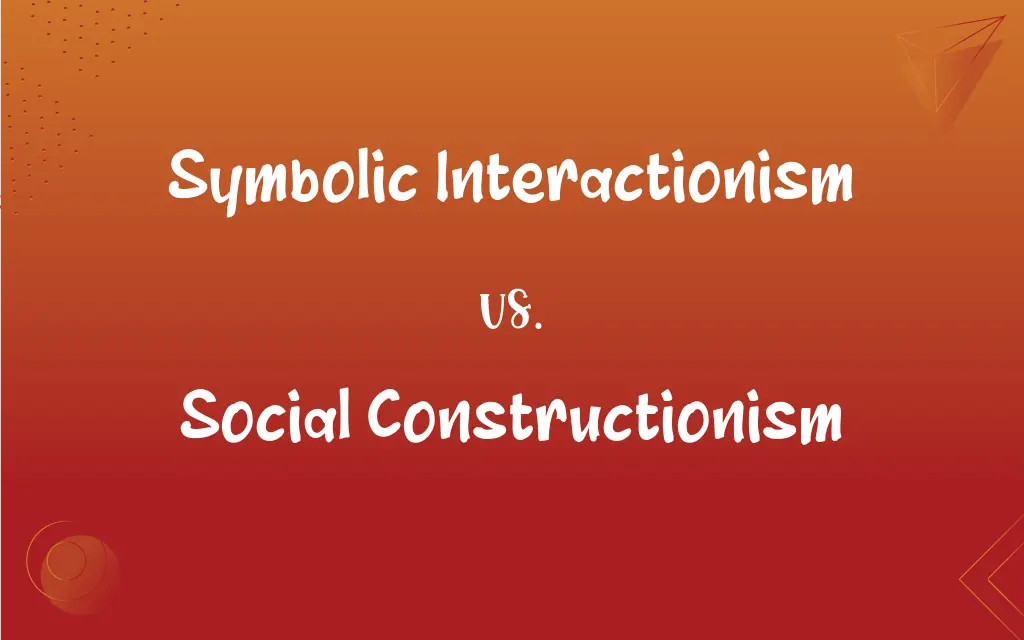Symbolic Interactionism vs. Social Constructionism: What's the Difference?
Edited by Aimie Carlson || By Harlon Moss || Published on March 4, 2024
Symbolic Interactionism is a sociological theory focusing on individual interactions and meaning-making through symbols, while Social Constructionism explores how social phenomena are created collectively through social processes.

Key Differences
Symbolic Interactionism emphasizes the individual's role in creating meaning through interactions using symbols (like language and gestures). Social Constructionism, on the other hand, focuses more on how societies as a whole construct realities and phenomena through collective agreement and interaction.
Symbolic Interactionism suggests that reality is shaped through personal interactions and the use of symbols, highlighting a more micro-level, individual perspective. Social Constructionism argues that social constructs and perceptions of reality are shaped by group dynamics and societal norms, reflecting a more macro-level approach.
In research, Symbolic Interactionism often relies on qualitative methods to understand individual perspectives and interpretations. Social Constructionism might use a variety of methodologies but is particularly interested in how groups collectively develop understandings and knowledge.
Symbolic Interactionism is often applied in studies of communication, relationships, and identity formation. Social Constructionism is frequently used in exploring how societal norms, roles, and institutions are created and maintained.
Symbolic Interactionism originated from the work of George Herbert Mead and other American pragmatists, focusing on the subjective aspects of social interaction. Social Constructionism, influenced by thinkers like Peter L. Berger and Thomas Luckmann, emphasizes the socially created nature of shared realities.
ADVERTISEMENT
Comparison Chart
Focus
Individual interactions and symbols
Collective creation of social realities
Approach to Reality
Shaped through personal interactions
Formed by group dynamics and norms
Methodology
Qualitative, individual-focused
Varied, with emphasis on group processes
Applications
Communication, relationships, identity
Societal norms, roles, institutions
Theoretical Origins
American pragmatism and G.H. Mead
Influences from Berger, Luckmann
ADVERTISEMENT
Symbolic Interactionism and Social Constructionism Definitions
Symbolic Interactionism
Symbolic Interactionism studies the process of meaning-making in social contexts.
Symbolic Interactionism can analyze how language shapes our understanding of identity.
Social Constructionism
Social Constructionism explores how societies collectively construct knowledge and realities.
Social Constructionism examines how societal norms about gender roles are formed.
Symbolic Interactionism
Symbolic Interactionism examines how individuals use symbols to create meaning in interactions.
Through Symbolic Interactionism, we understand how gestures vary in meaning across cultures.
Social Constructionism
Social Constructionism studies the social origins of seemingly natural concepts.
Social Constructionism challenges the idea that certain behaviors are inherently 'normal' or 'abnormal'.
Symbolic Interactionism
Symbolic Interactionism emphasizes the role of individual agency in social life.
Symbolic Interactionism shows how personal decisions impact social relationships.
Social Constructionism
Social Constructionism investigates how social contexts influence perceptions of reality.
Social Constructionism helps explain the varying cultural attitudes towards marriage.
Symbolic Interactionism
Symbolic Interactionism is concerned with the symbolic aspects of social interactions.
Symbolic Interactionism helps decode the significance of rituals in different societies.
Social Constructionism
Social Constructionism focuses on the creation of social phenomena through group interactions.
Through Social Constructionism, we can understand how money gains its value.
Symbolic Interactionism
Symbolic Interactionism focuses on subjective experiences in social interactions.
Symbolic Interactionism explains why people perceive the same event differently.
Social Constructionism
Social Constructionism emphasizes the role of collective agreement in shaping social constructs.
Social Constructionism analyzes how languages evolve through social consensus.
FAQs
What does Social Constructionism explore?
Social Constructionism explores how societies create social phenomena and realities collectively through social processes.
What is Symbolic Interactionism?
Symbolic Interactionism is a sociological theory focusing on individual interactions and meaning-making through symbols.
How does Symbolic Interactionism approach social change?
Symbolic Interactionism approaches social change as a process emerging from individual interactions and the reinterpretation of symbols.
How does Social Constructionism explain social norms?
Social Constructionism explains social norms as constructs developed and maintained through collective social agreement and reinforcement.
Can Social Constructionism be applied to physical objects?
Yes, Social Constructionism can be applied to understand how societies assign meanings and values to physical objects.
How does Symbolic Interactionism view individual experiences?
Symbolic Interactionism views individual experiences as subjective and constructed through interactions using symbols.
What is the focus of Social Constructionism?
Social Constructionism focuses on understanding how groups in society construct knowledge, norms, and values collectively.
What is a key difference in the methodologies of these two theories?
Symbolic Interactionism often employs more micro-level, individual-focused methodologies, while Social Constructionism can use a variety of methods to explore collective social constructs.
How does Symbolic Interactionism explain personal identity?
Symbolic Interactionism explains personal identity as a product of social interactions and the use of symbols, such as language and appearance.
How do Symbolic Interactionism and Social Constructionism view reality?
Symbolic Interactionism sees reality as shaped through individual interactions and symbols, while Social Constructionism views it as constructed through collective social processes.
What research methods are commonly used in Symbolic Interactionism?
Qualitative methods, particularly observational and interpretive techniques, are commonly used in Symbolic Interactionism.
Can Symbolic Interactionism be used to analyze cultural differences?
Yes, Symbolic Interactionism is useful for analyzing how different cultures use and interpret symbols differently.
Does Symbolic Interactionism recognize the influence of societal structures?
While focusing on micro-level interactions, Symbolic Interactionism also acknowledges how societal structures shape individual experiences.
Can Social Constructionism address issues of social inequality?
Yes, it can be used to analyze and challenge the socially constructed origins of inequality and discrimination.
Are Symbolic Interactionism and Social Constructionism compatible in sociological research?
Yes, these theories can complement each other in sociological research, providing insights at both individual and societal levels.
What role does language play in Social Constructionism?
In Social Constructionism, language is a crucial tool for constructing and communicating shared social realities.
Can Symbolic Interactionism help in understanding consumer behavior?
Yes, it can help in understanding how individuals use products as symbols and how this shapes consumer behavior.
How does Social Constructionism relate to power dynamics in society?
Social Constructionism examines how power dynamics influence the creation and maintenance of social constructs and norms.
What's the significance of Symbolic Interactionism in education?
Symbolic Interactionism is significant in education for understanding how teacher-student interactions influence learning and meaning-making.
How does Social Constructionism view historical events?
Social Constructionism views historical events as interpreted and given meaning through social contexts and narratives.
About Author
Written by
Harlon MossHarlon is a seasoned quality moderator and accomplished content writer for Difference Wiki. An alumnus of the prestigious University of California, he earned his degree in Computer Science. Leveraging his academic background, Harlon brings a meticulous and informed perspective to his work, ensuring content accuracy and excellence.
Edited by
Aimie CarlsonAimie Carlson, holding a master's degree in English literature, is a fervent English language enthusiast. She lends her writing talents to Difference Wiki, a prominent website that specializes in comparisons, offering readers insightful analyses that both captivate and inform.







































































